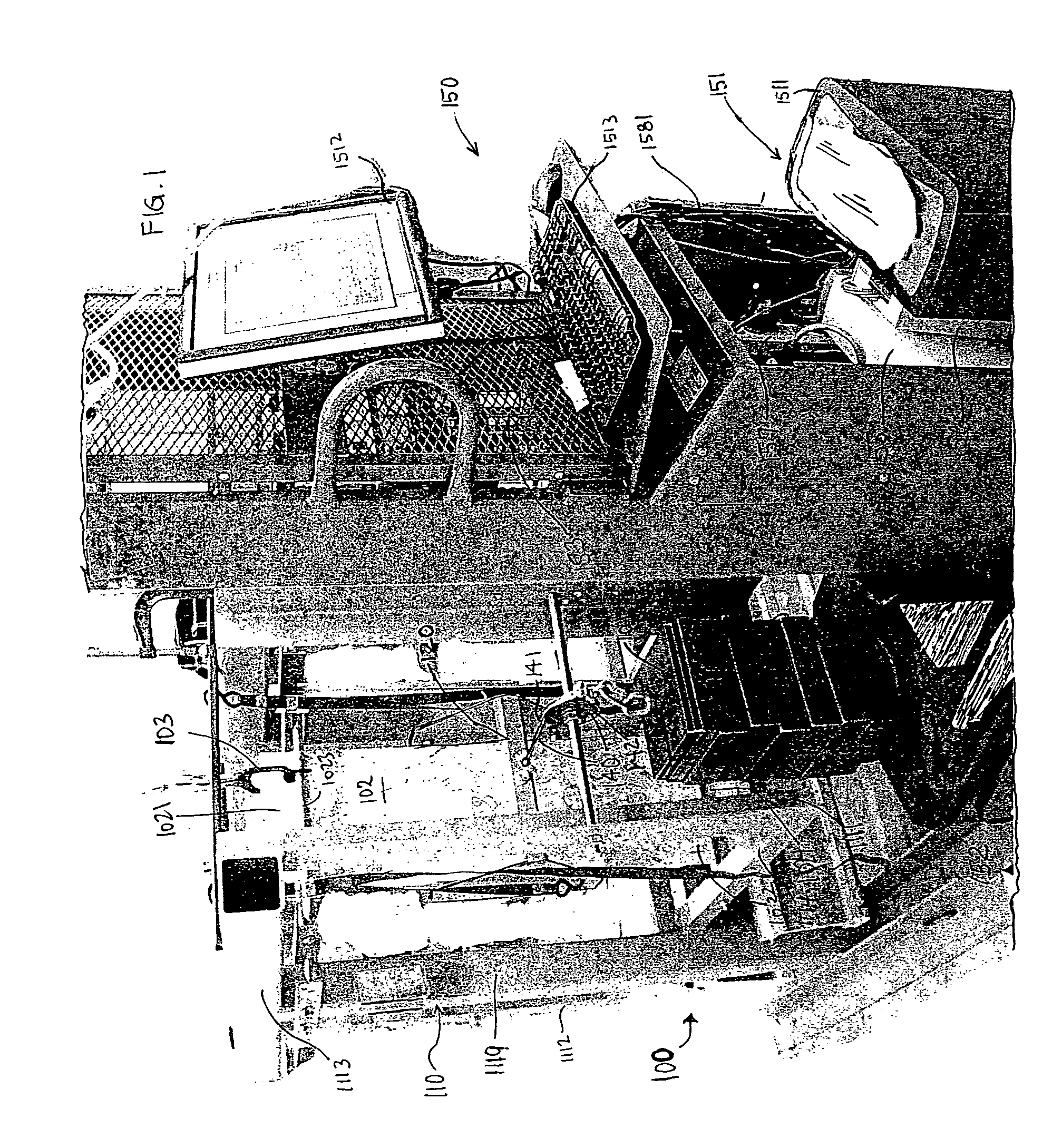[0013]The loading head assembly is operable to impart a load to a first major face of a
test panel between the retained opposite end portions of the panel. In one particular embodiment, the loading head assembly comprises two rectilinear contact rods for applying load to the first major face of a
test panel along two parallel lines of contact made by the respective rods along their lengths with the first major panel face, particularly wherein the rods are spaced apart a distance of about one-third the total span of the panel from the retained end portions to provide a three-point bending system.
[0017]In one particular embodiment, the
linear actuator comprises a
roller screw and rolling elements operably connected to a rotary
power transmission source and the output shaft. The
linear actuator may comprise, for example, multiple threaded
helical rollers assembled in a planetary arrangement around a portion of the output shaft comprising a threaded shaft, wherein the
linear actuator converts rotary motion into linear movement of the threaded shaft. A
constant power transmission source is provided to power the linear
actuator (e.g., a D.C.
servomotor, a D.C.
stepper motor, and a
constant torque A.C. motor). A
motor controller, such as a
processing card associated with an
actuator motor, controls the rate of linear movement of the output shaft of the linear
actuator. The linear actuator assembly has a position feedback assembly operable to generate signals corresponding to the position and velocity of the output shaft of the linear actuator. These signals are received and processed by the
motor controller in real-time. The
motor controller can maintain and, if needed, appropriately adjust the rate of output shaft movement via
motor control, to ensure a
constant rate of load transfer is maintained. The linear actuator assembly is mechanically coupled with the load-supporting platform such that it can lower the load-supporting platform during initial loading at a rate providing smooth transfer of weight from the platform to the load transfer assembly and hence the loading head. The linear actuator assembly is used to provide vertically movement (e.g., descent) of the platform at a controlled rate effective to load the cable component at a smooth, uniform rate with a progressively increasing amount of weight of the dead weight until the dead weight is fully suspended from the load transfer assembly, such as a cable component of a cable /
pulley assembly, and no longer supported in any amount by the platform of the mobile loading platform assembly. In one particular embodiment, the motor controller is operable to control the rate of weight loading to a constant value between 0.005 to 5 inch per minute until the weight is fully suspended from the cable and unsupported by the platform. Among other contributed advantages, this inventive arrangement can eliminate testing error which may be associated with use of a
hydraulic drive system for applying load in panel testing devices, which in turn provides more accurate and less variable results.
[0020]In one particular embodiment, the mobile loading platform assembly comprises a lift
truck frame supporting the platform, the linear actuator, the computerized
control system, and wheels for controlled movement of the lift
truck frame towards and away from the test panel support frame. In this mobile configuration, the mobile loading platform assembly unit of the panel testing system only needs to be physically present at a given panel testing
station for the initial loading stage of a panel creep test. Once loading to full stress load is achieved on a first test panel supported on a first
test frame at a first
test station using the mobile loading frame, the mobile loading frame can be redeployed for instituting initial loading of another test panel on another support frame at another
test station. In this manner, the loading frame and its associated components need not be physically stationed at one given
test station over the entire course of a load / deflection test period, such as a 90 day
constant stress period of a creep test cycle, for each panel being tested. Instead, the mobile frame can be efficiently used to initially load a plurality of test panels supported on a plurality of associated test frames at different test stations at a testing facility.
[0022]In another embodiment, there is a method of implementing a panel performance testing system encompassing multiple panel testing stations by initially loading a plurality of different test panels supported on different respective test frames at different respective test stations located in the same
test room by shuttling the same mobile platform assembly to successive different test stations after completing initial loading and while being absent during the
constant stress portion of a creep test cycle as performed on a test panel at a previous test
station. In this manner, the mobile platform assembly and associated components need not be dedicated to any given test
station, and instead can be used to support a plurality of test stations at a given
test facility, which improves testing efficiency and reduces equipment costs.
[0024]Additionally, the mobile loading platform assembly is a compact, maneuverable apparatus effective to help maximize the number of panel samples that can be loaded and concurrently tested at neighboring test stations in the minimal amount of space, since that space must be temperature and
humidity controlled to conduct creep tests. The panel performance testing system also is conducive for comparative testing and problem solving. For instance, studies of the affects of varying a load rate and / or load amount on a given type of test panel can be efficiently implemented using the inventive panel testing system and methodology, such as by initially loading a plurality of different test panels supported on different test frames at different test stations located in the same
test room in rapid succession by shuttling the same mobile loading platform assembly between each test station.
 Login to View More
Login to View More 


